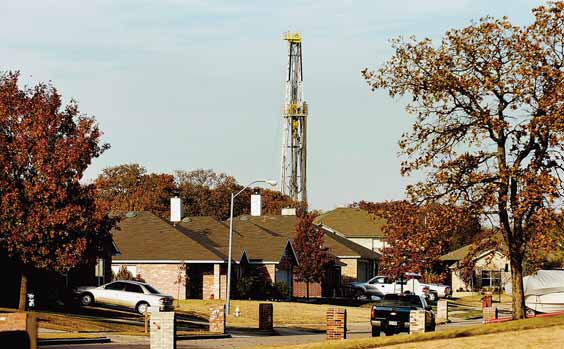SEJournal Online is the digital news magazine of the Society of Environmental Journalists. Learn more about SEJournal Online, including submission, subscription and advertising information.
By BILL DAWSON
 |
 |
|
Lowell Brown
|
Peggy Heinkel-Wolfe
|
| Photos: © Denton | Record-Chronicle |
As newspapers have shed reporting positions, practitioners and observers of environmental journalism have remarked that while the "environment beat," per se, may no longer be a formal position at as many publications, reporters with other assignments are doing high-quality work on environmental issues.
Lowell Brown and Peggy Heinkel-Wolfe of the Denton Record-Chronicle in North Texas have provided a notable example with their reporting on the impacts of the boom in drilling for natural gas in a shale formation. The two won first-place recognition in SEJ's 2009 awards category for Outstanding Small-Market Reporting, Print. The contest judges said their five-part series, "Behind the Shale," had set "the standard for reporting on environmental issues at small-circulation publications."
The judges added:
"With striking personal detail, the paper's reporters told a great behind-the-scenes story about how land deals really work in Texas. It's not a pretty sight: example after example showed how the tables are tilted to favor corporations and lawyers over residents and how little government agencies had done to curb abuses. While some of the other entries had more refined prose, the Record-Chronicle deserves the highest marks for laying bare an issue in which virtually everyone in the 18-county region of the Barnett Shale has a stake."
Brown and Heinkel-Wolfe responded to emailed questions about their reporting from SEJournal's Bill Dawson.
Q: First, tell me something about yourselves. How long have you been journalists? How long at the Denton newspaper? What are your jobs or beats there?
A: Lowell has been a writer, editor and page designer for daily newspapers since 2003. He's been a staff writer at the Denton Record-Chronicle for the past four years.
Peggy has been a journalist since 2000, freelancing with area dailies and weeklies until she started full-time with the Denton Record-Chronicle in December 2005.
We're both city hall reporters, with Lowell covering Denton and Peggy covering all the small cities — about 15 of them — around Denton.
Q: Generally speaking, how are environmental issues handled at the newspaper? Is there an environmental beat, per se? Besides natural gas impacts, what are some of the other environmental issues that receive coverage in the area that the newspaper covers?
A: Our paper doesn't have anyone dedicated to the environmental beat. We tackle environmental issues as part of our everyday coverage. We've written stories on development and the loss of open space, we regularly report on Texas Commission on Environmental Quality enforcement proceedings, and we have written stories on air and water quality. Denton County, by the way, is part of the regional non-attainment area [for ground-level ozone] encompassing Dallas and Fort Worth.
Q: Natural gas drilling in shale formations has become controversial in various parts of the United States in recent years due to growing concern about the environmental impacts. For SEJournal readers who aren't familiar with that issue or with your area, please provide a little background information about the Barnett Shale — what and where it is, how gas drilling has increased there in recent years, and how urban areas have been affected.
A: The Barnett Shale is a massive gas field that spans more than a dozen counties in the western Dallas-Fort Worth area. The gas isn't new; the technology to get at it profitably is. When wells started popping up in urban areas several years ago — often next to homes and schools — people complained about the noise and traffic from the heavy trucks and machinery. Since then, evidence is mounting that more serious problems can accompany gas drilling and production, including cancer-causing chemicals in the air and water supplies.
Other events here have led to more scrutiny of the industry, even if they haven’t been conclusively tied to gas drilling operations. Public water wells in three North Texas towns were shut down recently after state regulators reported finding increased radiation levels. Some locals blamed the problem on gas drilling activities, including a malfunctioning wastewater disposal well in one of the towns, but state officials said they found no definitive link. Some scientists blamed a series of minor earthquakes last year in Cleburne, south of Fort Worth, on extensive gas drilling there. Also, state health officials are investigating a leukemia cluster in the Denton County town of Flower Mound.
State regulators have said they need more evidence on the health effects of gas drilling to support a moratorium, feeding a perception among environmentalists that the state is asleep at the wheel on the issue.
Q: How did your series come about — why did you and the newspaper decide to undertake it at the time you did? Was it an outgrowth of previous reporting on drilling impacts? Was the series the first time you had reported as a team?
A: The project was an outgrowth of previous reporting. In 2006, we wrote a host of stories that tackled various issues with the intense shale development, from the rights of cities to govern themselves, to the rights of property owners to protect their interests to the environmental impacts. While it wasn’t the first time we worked on a story together, it was the first time to work as a team on something large-scale. We decided ahead of time how we would divvy up the duties. After we started reviewing our early drafts, Lowell quipped — if someone cried, he wrote it, if someone died, Peggy wrote it.
Q: Your series pays close attention to one neighborhood in the small town of Argyle, near Denton. How and why did you decide to focus on that community? What were some of the key citizen concerns and complaints there that you examined and documented?
A: The battle in that particular neighborhood looked like one that could be an excellent backdrop for a narrative that we hoped would take two years’ worth of reporting and put it together in a way that our readers could understand the impact.
A pad site sat only 250 feet from some of the homes — a towering, rocky plateau where a tree-lined hill used to be. The construction re-routed the flow of rainwater, and pools and homes now flooded with a modest rainfall. The government was little help to these neighbors — in Texas, energy companies enjoy enormous legal leeway — but they’d managed to delay the drilling so far, mostly by pointing out the drilling company’s disregard for city development codes.
It helped that the main characters of the story were willing to work with us. The story’s direction really took shape when the neighbor closest to the well, a mother of two young boys, confessed her inner turmoil. Thoughts of a well explosion haunted her, but by giving voice to them she felt as though she failed to live up to the tenets of her Christian faith. Nowhere had we seen this depth of emotion conveyed in media reports about gas drilling. The issue for these neighbors isn’t noise or dust, we realized. It’s the basic human need to feel safe in your home.
Over the months that followed we spent countless hours talking to sources, transcribing interviews and sorting through mundane government documents, but we never lost sight of our goal. We were, in the words of Gay Talese, telling stories with real names.
 |
|
A natural gas rig drilling a horizontal well towers over a neighborhood southeast of Denton, near Corinth, Texas. © Photo by Al Key, Denton Record-Chronicle.
|
Q: Besides the attention to Argyle, how and why did you choose the various sub-topics that you explored in the different stories that made up the series?
A: We were ambitious and/or naïve enough to think we could write the single most comprehensive story about urban gas drilling ever published. So we knew we had to offer a broad view of the industry while following the narrative of what happened in this one neighborhood.
Luckily for us, their story was complex enough that we could easily break off and explore the larger issues we knew were critical to understanding the industry, including the lust for money and the short- and long-term environmental problems involved.
Q: How long did you spend on the project? Were you obliged to keep up with your regular reporting duties at the same time? The series represents an impressive commitment of time and resources. Was it your idea or an editor’s idea? If it was yours, was it hard to persuade your bosses to let you do it? Does the newspaper produce many such in-depth projects?
A: The story was our idea and we didn’t have any trouble convincing our editors to do it. It took about six months to pull it together, chipping away at it a couple of hours each week to assemble what we needed. We each got a week off to write our portion. During his writing week, Lowell checked himself into a hotel for part of the time. Peggy moved to an unused cubby in a quiet corner of the building.
This was the first time our paper had run something on this scale, and in narrative form, so we were all cutting our teeth on what was required to make that work, particularly in the editing process.
However, every year, we make time during Sunshine Week to do a large-scale project. Other projects come together as the need arises. Usually, reporters just pitch in to help cover another reporter’s beat as they tackle something big, whether it’s the detailed examination of poorly run election or the prosecution of a cop-turned-murderer.
Q: The natural gas industry exerts a lot of influence and has a lot of supporters in Texas and in other places where it’s an important part of the economy. Describe the reactions your series got from the public, government officials, business and industry leaders. Was there a significant negative response?
A: The response from the community was so positive it far outweighed the negative reaction of the industry. We know journalists covering other shale development have used our coverage as a template for what to question, but our favorite compliment was a local one. A city planner said he was clipping and saving the story because it helped him understand what was going on better than any other resource he had.
Q: Natural gas drilling in the Barnett Shale region has continued to be highly controversial in the 14 months since your series was published in late 2008. Air pollution issues, such as benzene emissions and drilling activities’ contribution to ozone levels in North Texas, have gotten a lot of media attention in the region during that time. Tell me about your own coverage since the series ran. Are the two of you still covering drilling as a reporting team or individually? If so, what are some of the subjects and developments that you’ve written about and continue to pay attention to?
A: The beginnings of the benzene controversy can be traced to Peggy’s regular reporting duties in Dish. In May 2009, Dish residents were upset when an industry-funded study of air quality there showed no problems. The Dish Town Council voted to commission an air quality study of its own. Peggy was the only reporter in Dish that night. The town hired an environmental firm to take measurements and write up a report. Peggy was there again when the results were released, but so were a lot of other reporters because state and federal officials had gotten word that the results were troubling.
We both continue to follow the health concerns surrounding drilling as well as the emerging activism towards regulatory reform. Most of the time, those issues emerge at one city council meeting or another. For example, another Denton County town, Flower Mound, is experimenting with the concept of centralized wastewater collection along with centralized compression, where companies place gas compressors for multiple wells at a single location. That sets up a host of environmental justice concerns.
After the Texas Railroad Commission ultimately did not approve the permit for drilling in the Argyle neighborhood featured in our series, we started working as a team on a followup story. But the leaseholder has not yet given up on that spot, so we’re working with a moving target there.
Bill Dawson is assistant editor of the SEJournal. He can be reached by email at b.dawson@earthlink.net












 Advertisement
Advertisement 



